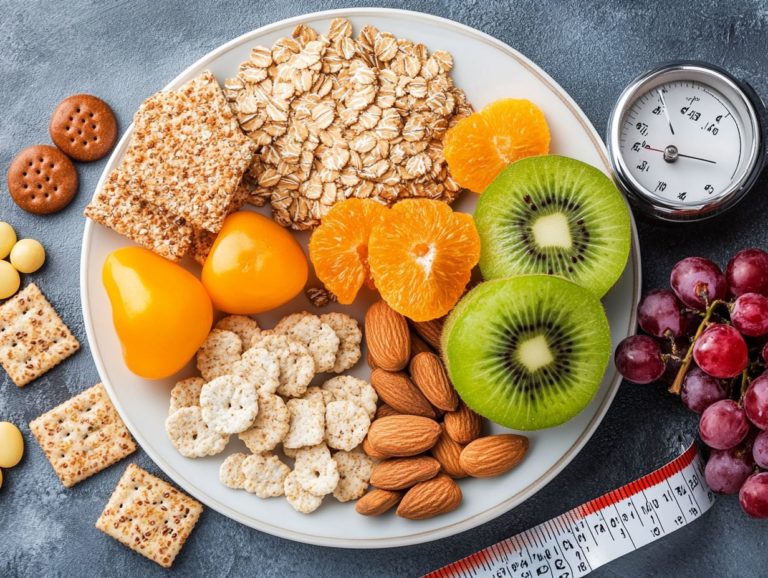Nutrition Labels: How to Read and Understand Them
Nutrition labels serve as more than a mere inventory of ingredients; they are important tools for making informed food choices.
When you grasp their components serving sizes, calorie counts, fats, carbohydrates, proteins, and daily values you can profoundly influence your health. This article breaks down the essential elements of nutrition labels, offers insights on how to interpret them effectively, and presents strategies for comparing products tailored to your dietary needs.
Get ready to equip yourself with knowledge that can pave the way for healthier eating habits!
Contents
Key Takeaways:

- Check the serving size and calories to stay on track!
- Familiarize yourself with key nutrients and daily values for informed food choices.
- Pay attention to ingredient lists and compare products to suit your dietary needs.
What are Nutrition Labels?
Nutrition labels are important tools provided by the FDA, giving you essential information about food products. These labels help you make informed choices that contribute to a healthier lifestyle.
Within their carefully crafted design, you ll discover essential details such as calories per serving, serving size, and various nutrients. This information allows you to see how specific food items align with your dietary needs and preferences, ensuring you stay on track with established dietary guidelines.
Definition and Purpose
The essence of a nutrition label lies in its ability to provide you with essential information that guides you toward healthier food choices.
These labels are vital for understanding the nutritional content of packaged foods. They showcase details such as serving sizes, calorie counts, and the breakdown of macronutrients: fats, carbohydrates, and proteins. They also highlight important vitamins and minerals, helping you evaluate how a particular food fits into your overall dietary needs.
By mastering the art of reading these labels, you empower yourself to make informed decisions that align with your health goals, nurturing a balanced diet and enhancing your overall well-being. Therefore, becoming familiar with nutrition information is essential for anyone aiming for a healthier lifestyle.
Components of a Nutrition Label
A nutrition label features several essential components that offer a detailed overview of food products. You ll find information on serving size, calorie content, and key macronutrients, as well as crucial micronutrients like dietary fiber and protein.
This wealth of information enables you to make informed dietary choices.
Serving Size and Calories
The serving size on a nutrition label indicates the recommended amount of food, while the calories per serving show the total calories you may consume.
Understanding this concept is vital for anyone striving to maintain a balanced diet. If you consume multiple servings, you might exceed your daily caloric needs, leading to unintended weight gain or nutritional imbalances. Focus not only on the calorie count but also on how those calories align with your individual dietary goals.
By understanding the importance of serving sizes, you gain better control over your intake, ensuring that you nourish your body effectively while still enjoying a diverse range of foods.
Macronutrients and Micronutrients

Nutrition labels neatly categorize nutrients into macronutrients and micronutrients. Macronutrients include dietary fiber and protein. Micronutrients encompass essential vitamins and minerals.
Understanding the roles these nutrients play is crucial for fostering a balanced diet that promotes your well-being. Macronutrients are your primary source of energy, fueling your daily activities. In contrast, micronutrients support various body functions vital for growth, development, and immune function.
Together, these nutrients form the backbone of healthy eating. Consuming a diverse array of foods helps achieve a well-rounded intake. Striking the right balance between macronutrients and micronutrients enhances physical health and supports mental clarity and emotional stability. This reveals the intricate relationship between what you eat and how you feel.
Daily Values and Percentages
Daily values and percentages on nutrition labels help you grasp the nutritional contribution of a serving of food in relation to your overall dietary guidelines.
These values are based on a 2,000-calorie daily diet, serving as a benchmark for healthy eating patterns. They are calculated using scientific research and dietary recommendations from health organizations, ensuring they reflect the nutritional needs of the general population.
By comparing a food item s nutrients to these daily values, you can determine if a product aligns with your dietary goals. The presence of these labels plays a crucial role in public health, allowing you to make better-informed choices that lead to improved health outcomes.
Interpreting Nutrition Labels
Interpreting nutrition labels is essential for understanding the nutritional values of your food and making informed choices. It’s vital to be mindful of ingredient lists and key nutrients. For more insights, check out understanding food labels. This awareness helps you select foods that align with your health goals.
Understanding Ingredient Lists
Ingredient lists on nutrition labels outline the components of food products. This helps you identify potential food sensitivities and allergies.
Understanding these lists is vital, especially if you have specific dietary restrictions. A careful read can unveil allergens that might not be immediately apparent, like cross-contaminants or hidden additives. For those managing food sensitivities, knowing how to interpret each item provides the confidence to make informed choices.
By recognizing common problematic ingredients, you can effectively avoid adverse reactions. This ensures your meals remain both safe and enjoyable.
Staying informed about what s in food products enables you to maintain your health and well-being more effectively.
Identifying Key Nutrients
Identifying key nutrients on a nutrition facts label is crucial for making informed choices. This helps you achieve a balanced intake of food nutrients. By diving into this vital information, you gain a clearer understanding of the content in various food products.
Focusing on essential nutrients such as proteins, fibers, vitamins, and minerals allows you to prioritize what to include in your daily meals. Recognizing how these nutrients contribute to your overall health objectives like weight management, improved digestion, or enhanced energy levels enables you to make choices that support your long-term wellness goals.
Adopting this approach fosters a more informed and conscious way of eating.
Using Nutrition Labels to Make Informed Choices

Using nutrition labels effectively enables you to make informed choices about your food consumption. This ensures you select meals that not only satisfy your palate but also align perfectly with your dietary needs.
Start reading labels today and take control of your health!
Tips for Comparing Products
When comparing products, assess factors such as calorie counts, serving sizes, and the balance of food nutrients to make healthier choices.
To truly understand what you’re consuming, start by examining the serving size listed on the label. This will help you grasp how the calorie counts relate to what you typically eat.
Focus on key nutrients like saturated fats, sugars, and sodium, as these can significantly impact your overall health. Aim for products that provide essential vitamins and minerals while keeping the calorie count in check.
By making these comparisons, you’ll be able to identify the healthiest options available without feeling overwhelmed.
Accounting for Personal Dietary Needs
Accounting for your personal dietary needs is vital if you’re looking to maintain a healthy lifestyle. This often means seeking guidance from registered dietitians who can help you navigate health issues and dietary recommendations.
Tailoring your food choices is essential for managing long-term health issues and optimizing your overall wellness and energy levels.
Nutrition labels become your best allies in this decision-making process, providing valuable insights into ingredients and nutrient content. Focus on serving sizes, added sugars, and types of fats to make informed choices that align with your health goals and personal preferences.
Understanding these labels enables you to take charge of your diet, allowing for flexibility while ensuring you are getting the right nutrients. This fosters a more balanced approach to eating, making it easier to enjoy the food you love while prioritizing your health.
Frequently Asked Questions
What is a nutrition label and why is it important?
A nutrition label is a panel found on food packaging that provides important information about the nutritional content of a food product. Knowing what s in your food helps you make smarter choices right now!
How do I read a nutrition label?

Start by looking at the serving size and number of servings per container. Then, check the total calories and the amounts of fat, carbohydrates, and protein. Pay attention to the % Daily Value (%DV) for various nutrients. Finally, review the ingredient list for any allergens or additives.
What is the difference between total fat and saturated fat on a nutrition label?
Total fat includes all types of fat in a food product, while saturated fat specifically refers to solid fats. These are often found in animal products and can contribute to high cholesterol levels. It is recommended to limit saturated fat intake to less than 10% of your daily calories.
How can I use a nutrition label to make healthier choices?
Pay attention to the %DV for nutrients such as sodium, added sugars, and saturated fat. Aim for lower percentages for these nutrients, as they can contribute to health issues when consumed in excess. Also, look for foods with higher amounts of vitamins, minerals, and fiber, as these are important for overall health.
What is the importance of the ingredient list on a nutrition label?
The ingredient list provides information about the components of a food product and can help identify potential allergens or additives. Ingredients are listed in descending order by weight, so the first few ingredients make up the majority of the product. Be cautious of foods with long ingredient lists or unfamiliar ingredients.
Are all nutrition labels the same?
Nutrition labels vary by country and manufacturer but provide similar information to help consumers make informed choices about the foods they consume.
Start reading nutrition labels today and take charge of your health!






